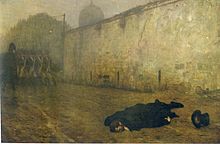Second White Terror
Suspected sympathizers of the French Revolution (including former Jacobins), Republicans, Bonapartists and, to a minor degree, Protestants, suffered persecution.
[1][2] Several hundred were killed by angry mobs or executed after a quick trial at a drumhead court-martial.
[1] After the Hundred Days, Napoleon's brief return to power in 1815, the second White Terror focused mainly on the purging of a civilian administration which had almost completely turned against the Bourbon monarchy.
There were about 300 mob lynchings in the south of France,[5] notably in Marseille, where at least eighteen of his Mamelukes were massacred in their barracks.
Meanwhile, the upper house, the Chamber of Peers, whose members were appointed by the King and served at his pleasure, sentenced Marshal Michel Ney and the Comte Charles de la Bédoyère to death for treason, while 250 people were given prison sentences and some others exiled, including Joseph Fouché, Lazare Carnot, and Cambacérès.

